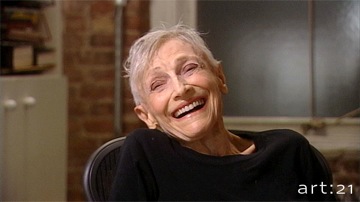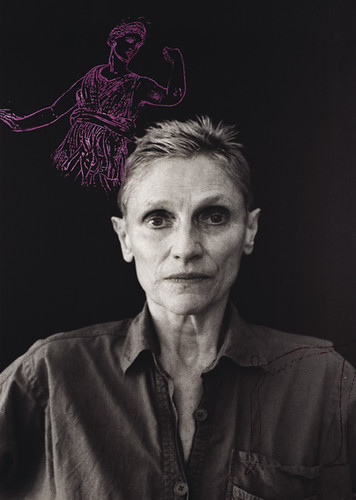Nancy Spero, artist, feminist, activist, wife, mother, and a great presence in the art world, passed away yesterday. She was 83 years old. The above video snippet from last year's Art:21 gives some idea of her modesty, her fierce intelligence, her unpretentious brilliance. She will be sorely missed.
I knew Nancy and her husband, the artist Leon Golub (1922-2004), particularly in the mid-1980s, when I was curating art exhibitions, and was able to place their work in shows such as Situation, Totem, Body Politic and Stigmata. I showed work from her ongoing series of long paper scrolls with pressed, printed and collaged images of iconic female forms, multicultural pictographs of women through the ages.
From her Wikipedia entry:
An activist and early feminist, Spero was a member of the Art Workers Coalition (1968-69), Women Artists in Revolution (1969), and in 1972 she was a founding member of the first women’s cooperative gallery, A.I.R. (Artists in Residence) in SoHo. It was during this period that Spero completed her "Artaud Paintings" (1969-70), finding her artistic “voice” and developing her signature scroll paintings: Codex Artaud (1971-1972). Uniting text and image, printed on long scrolls of paper, glued end-to-end and tacked on the walls of A.I.R., Spero violated the formal presentation, choice of valued medium and scale of framed paintings. Although her collaged and painted scrolls were Homeric in both scope and depth, the artist shunned the grandiose in content as well as style, relying instead on intimacy and immediacy, while also revealing the continuum of shocking political realities underlying enduring myths.

In 1974, Spero chose to focus on themes involving women and their representation in various cultures; her Torture in Chile (1974) and the long scroll, Torture of Women (1976, 20 inches x 125 feet), interweave oral testimonies with images of women throughout history, linking the contemporary governmental brutality of Latin American dictatorships (from Amnesty International reports) with the historical repression of women. Spero re-presented previously obscured women’s histories, cultural mythology, and literary references with her expressive figuration.

Developing a pictographic language of body gestures and motion, a bodily hieroglyphics, Spero reconstructed the diversity of representations of women from pre-history to the present. From 1976 through 1979, she researched and worked on Notes in Time on Women, a 20 inch by 210 foot paper scroll. She elaborated and amplified this theme in The First Language (1979-81, 20 inches by 190 feet), eschewing text altogether in favor of an irregular rhythm of painted, hand-printed, and collaged figures, thus creating her “cast of characters.” The acknowledgement of Spero’s international status as a preeminent figurative and feminist artist was signaled in 1987 by her traveling retrospective exhibitions in the United States and United Kingdom. By 1988, she developed her first wall installations. For these installations, Spero extended the picture plane of the scrolls by moving her printed images directly onto the walls of museums and public spaces.

Harnessing a capacious imaginative energy and a ferocious will, Spero continued to mine the full range of power relations. In 1987, following retrospective exhibitions in the United Kingdom, the United States and Canada, the artist created images that leapt from the scroll surface to the wall surface, refiguring representational forms of women over time and engaging in a dialogue with architectural space. Spero’s wall paintings in Chicago, Vienna, Dresden, Toronto, and Derry form poetic reconstructions of the diversity of representations of women from the ancient to the contemporary world, validating a subjectivity of female experience.
I often visited Nancy and Leon in their loft on La Guardia Place, just north of Bleecker Street. It was a wonderful place, a true salon where they surrounded themselves with great people, intelligent discussion, political commitment, and a free and generous spirit.
Nancy and Leon met at the Art Institute of Chicago in the late 1940s, got married in 1950, traveled and lived together in Europe, had three sons, and moved to their downtown New York studio in 1964. They were married for 53 years, until his death in 2004. She has now gone to join him. They were a great art couple, cherishing each other, challenging each other, proceeding always with fondness and joy.

Nancy Spero. There will not be another like her. R.I.P.

Holland Cotter's obit of Nancy Spero
Holland Cotter published an obituary of Nancy Spero in yesterday's NY Times. It includes the following text: